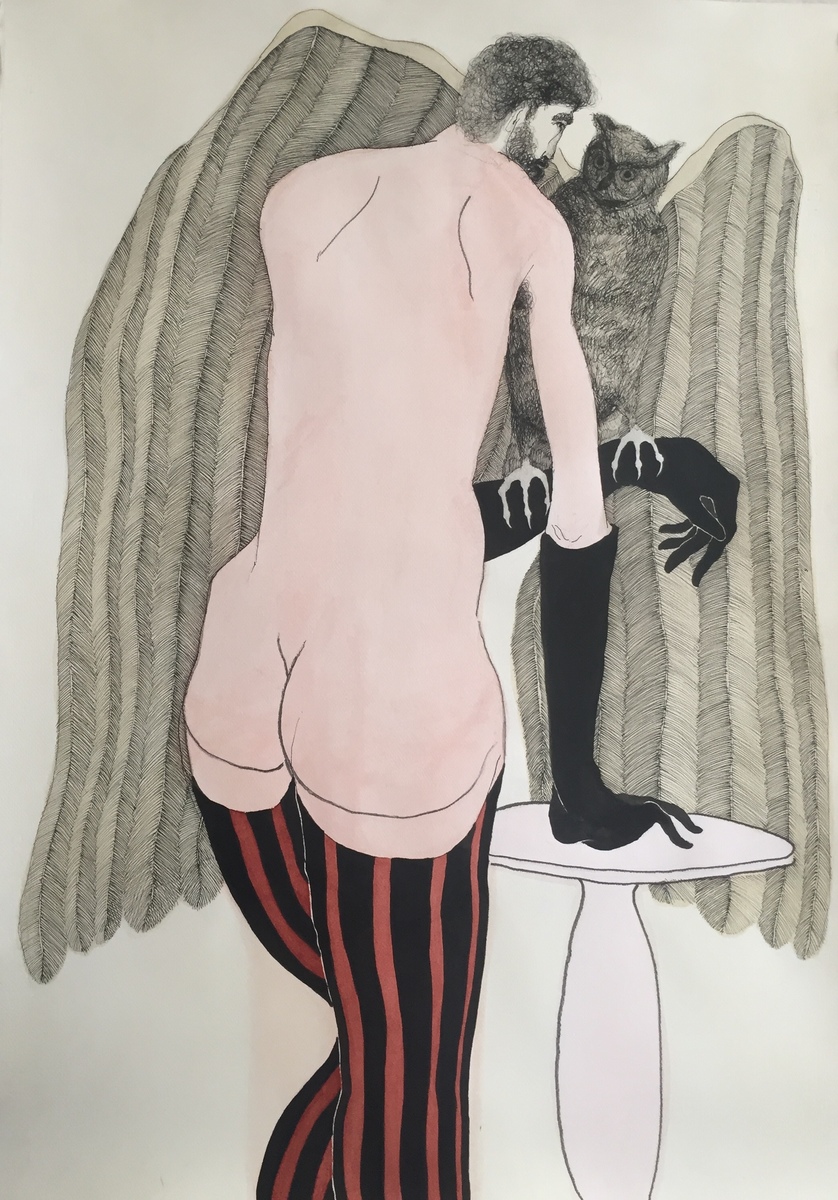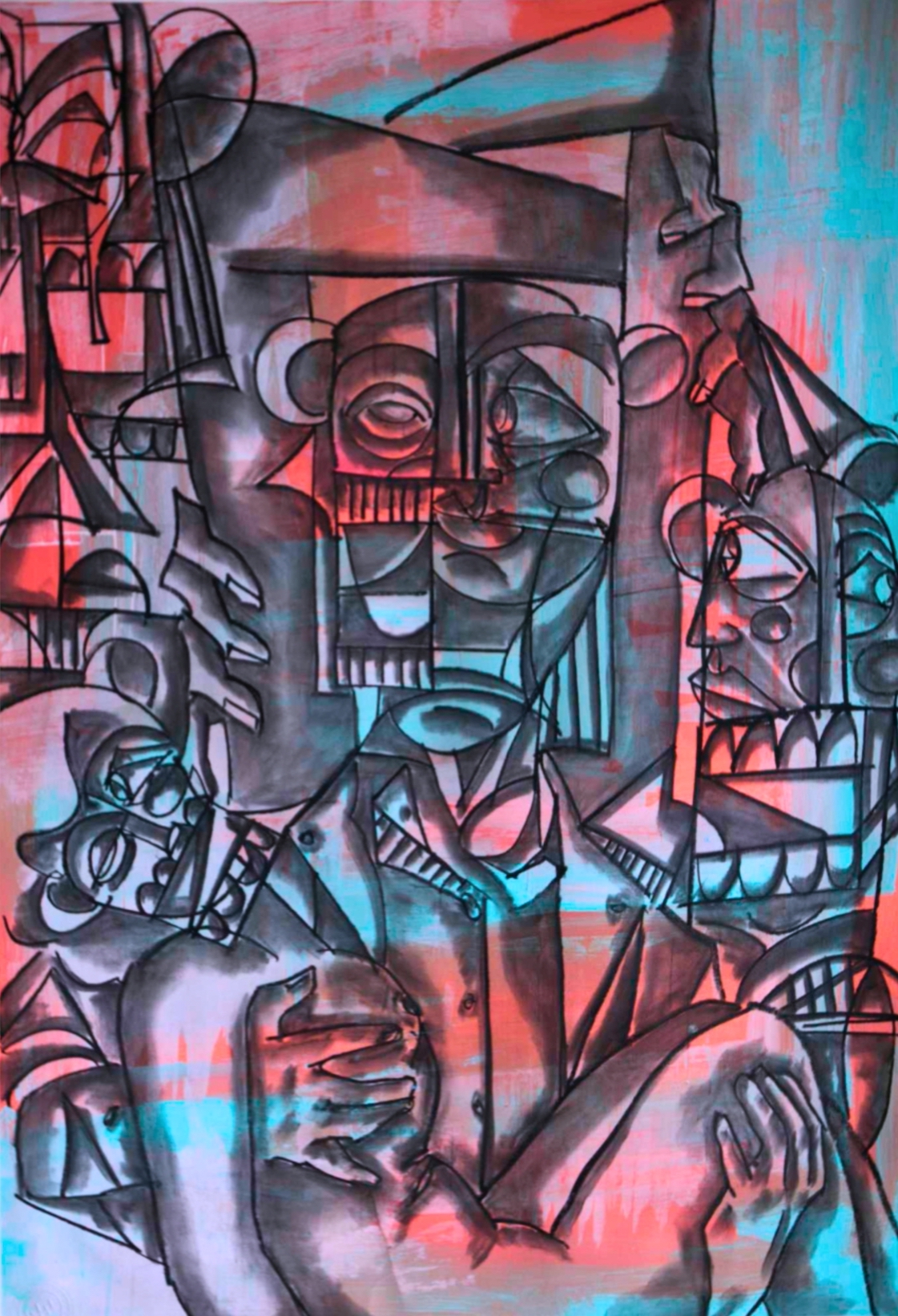Emerging voices turn up the HEAT on Cape Town's art scene
By Mary Corrigall
-------------
If you peruse the 16 art exhibitions and live programming of the HEAT Festival, you aren't likely to see the names of too many famous artists. The HEAT Winter Arts Festival was not originally tailored for young or emerging artists. This focus occurred organically - as a nascent festival, it made sense to unearth new talent, and a fresh point of view. The festival was also a result of the initial inspiration, which focused on the small to medium-sized art dealers in Cape Town's city centre. Research during an arts journalism project in 2023, which coincided with the winter season, starkly revealed the impact of the bad weather and low tourist season on foot traffic and sales.
 Raymond Fuyana, Dark Night, 2022, oil and acrylic on canvas, will show at Ebony/CURATED's exhibition 'as we see it...'
Raymond Fuyana, Dark Night, 2022, oil and acrylic on canvas, will show at Ebony/CURATED's exhibition 'as we see it...'
Is there potential for downtime in Cape Town's art market? If so how could interest and foot traffic be increased to the 16 or more art galleries in winter when even well-heeled Capetonians follow the swallows (European expats who avoid winter in both hemispheres) to Europe during this time of year?
Some of the art world's innovative ideas originated from addressing downtime woes. Indeed the concept of art fairs in Europe - which started in 1967 with Art Cologne in that German city came out of a need to turn attention not only to contemporary art but to assert relevance to trading outside the economic capital - Bonn.
HEAT is not an art fair - it is somewhat of a different animal in that visitors have 12 days to view art across the 16 gallery spaces that are participating which include: artHARARE, The AVA, Christopher Moller, Ebony/Curated, Eclectica Contemporary, Kalashnikovv, 99 Loop Gallery, Iziko South African National Gallery, Michaelis Galleries, Nel Gallery, Reservoir Projects, Sisonke Gallery, Under the Aegis, Hub gallery, Union House by Spier Arts Trust, Vela Projects and WORLDART.

Stephen Allwright, courtesy of the artist
The upside of downtime is that art dealers are willing to take some risks. Many of the participating dealers are working with artists they have not had relationships with previously and/or a younger group of artists. This is also the product of the theme set for the festival - Common Ground - by my co-curators Voni Baloyi, Andrew Lamprecht and Nkgopoleng Moloi.
This concept was rooted in our interest in what conditions would bring not only our local art community together during the cold season but more broadly our society. With her thoughts on the 30 years of democracy anniversary Baloyi, the youngest on our team, was particularly interested in the tensions embedded in social cohesion - "there has to be an acknowledgement of difference coupled with every individual, whether Black, Coloured, Indian, white, or Asian must feel as though they have a stake in this country, geographically, politically, and economically," she opined in The Daily Maverick.
In line with this, our thinking was on the socio-political context we have birthed for the next generation. This coincided with our partnerships for the live programming with Opera UCT, who have curated a programme of operatic performances showcasing some of their top students. The jazz component, curated by Slowlife, a peripatetic jazz platform, also champions rising musicians.
 Dada Khanyisa - uBab'omncane eThekwin ngo 87, 2024, Walnut, Jelutong, Kiaat, Greenheart, Mdf and Pine wood on painted canvas and pine ply wood
Dada Khanyisa - uBab'omncane eThekwin ngo 87, 2024, Walnut, Jelutong, Kiaat, Greenheart, Mdf and Pine wood on painted canvas and pine ply wood
How do young people position themselves in relationship to the multiple communities in South Africa and indeed in contrast to Gen X or Millenials? This question, more or less has become the lens through which the artworks on HEAT and - the other live performance works - can be read.
99 Loop gallery has tackled this idea directly presenting an exhibition of self-portraits by a range of artists - from different backgrounds and generations - that include Rory Emmett, Heidi Fourie, Paul Wallington, Stephen Allwright, Clare Menck, Nazeer Jappie, Colijn Strydom, Alexis Schofield, Robert Hamblin, Ilené Bothma, Gene Lesouw, Oda Tungodden, Olivia Botha, and Leila Abrahams.
As expected their renderings are all unique, not only in their vocabularies but in how they view themselves. Bothma has characteristically, concealed her face beneath a gauze, while Menck floats in water in the distance. Jappie - a newcomer to the art scene - presents his disembodied head adjacent to a cyprus tree - which denotes mourning, death. He is fascinated by how certain well-publicised deaths in the news bind communities across the globe.
Jappie is one of the interesting new voices that will demand interest in the HEAT exhibition programme. Ebony/CURATED have purposefully presented a selection of artists that exemplified a breadth of new artistic talent rising to the fore of the South African art scene in a group exhibition titled, as we see it... This has included; Thando Phenyane, Hanna Noor Mahomed, Raymond Fuyana, Sechaba Hoha, Blessing Rooi, Feni Chulumanco, Rentia Retief, Abongile Sidzumo, Aviwe Plaatjie, Balekane Legoabe, Liam Van Der Heever and Lindisipho Gulwa. Phenyane is particularly interesting. Even though he is focused on upturning the representation of the black figure, he takes an interesting path heavily influenced by Francis Bacon, though conceptually rooted in Zakes Mda's Zulus in New York.
Naturally, some young artists whose work stood out at the RMB Latitudes are rising to the top of the HEAT Festival. Such as Van der Heever - with his vivid surreal pop paintings - and Charity Vilakazi who will show a suite of paintings under the title, Alikho izulu? (Is there no heaven?), at Kalashnikovv's newly opened Cape Town gallery, in which she channels her grief after her grandmother's passing but also her connection to her and other ancestors which is sustained beyond the naked eye.
Treasure Mlima, who caught my attention for the first time at RMB Latitudes, is also interested in using his art to remain connected to his ancestors. This doesn't manifest directly in the content of the works he has produced for an exhibition at Reservoir curated by Lebo Kekana, fittingly titled: Indlela ibuzwa kwaba phambili. (Direction is sought from those who have come before (are ahead.) Kekana, who also shaped parts of RMB Latitudes programming, may be twenty-three but he is carving out a name for himself, not only as the director of FEDE, but at the HEAT Festival. His exhibition at Reservoir is thoughtful, centred on how materials - particularly wood have influenced the expression of a new generation of artists.
Mlima spiritually communes with his ancestors while making his art, made from carving wood into flat picture frames. In this way, the community that he feels most connected to is the one that is no longer living in the physical realm.
"That's a community that I look towards and try to bring alive, by creating the medium between our physical realm and their ancestral. It's (my way) of thanking them for carrying me this far," says Mlima.

Ferai Engelbrecht's Mavambo, Saviour Syndrome, Chalk pastel, charcoal and Japanese ink on Fabriano paper. Is part of artHARARE's 'Mavambo' (the Beginning) exhibition.
What is particularly striking about the exhibitions - and the theatre programme - is the strong LBTQI slant - or the 'Queering of the world" as one commentator put it. Undoubtedly, artists are more open about exploring their sexuality. The theatre programme features several non-binary and queer performers - from Pichi Keane - a non-binary drag queen to Andi Colombo, Aldo Brincat and others, addressing the vagaries of their daily lives, and histories. Love, the search for it and sustaining it is at the heart of these stories.
Nel gallery presents a collection of photographic works at Pride and Prejudice by Toscaneena, a queer art duo consisting of Tosca Marthinus and Neena Borrill, who represent their love depicted through the intertwining of their bodies through black and white photographic works.
Desire Marea's exhibition of paintings of Zulu warriors in love on the battlefield of Islandwana, Baddies of Isandlwana, showing at Eceletica Contemporary is attracting attention. Not only because Marea is a well-known international musician and performer but the unexpected, yet endearing love scenes he presents that challenge Zulu machismo and history.
"Putting your life on the line (in a battle) or being in defence of something is romantic... I was also thinking about what they were fighting against - the British," says Marea.
Ultimately, Marea suggests that while the queer communities have had to unite to gain acceptance and to be acknowledged for their contribution to wider communities, "the end goal is to integrate ourselves."
Blurring the hard lines between identities has surfaced through a number of shows, particularly those which include artists from other African countries such as Christopher Moller’s Transcending Boundaries, which include works by Abalade Glover to Olamide Ogunde.
Promoting the art of Zimbabwean artists is, of course, the focus of artHARARE’s debut show at their new Bree Street gallery, though it demonstrates through a range of works by Farai Englebrecht, Tafadzwa Gwetai, Anusa Salanje, Sindiso Nyoni, Nicky Mariga, Richard Mudariki, Mostaff Muchawaya and Dan Halter, that geographical positions might be the source of connection but don’t’ always translate into a united worldview.
- HEAT Festival takes place from July 11 to 21. Visit www.heatfestival.org
Further Reading In Articles
African Artist Directory















